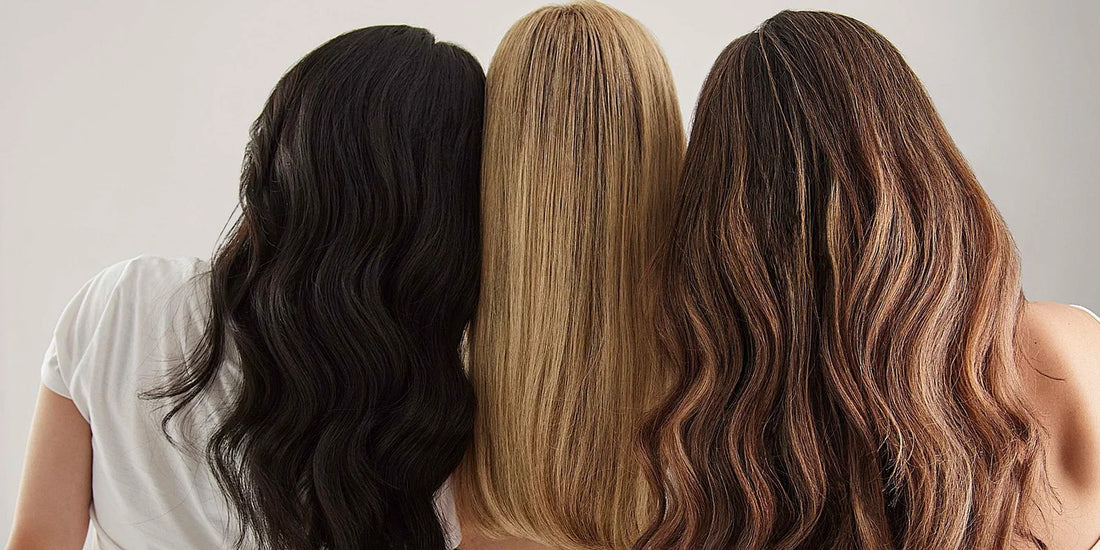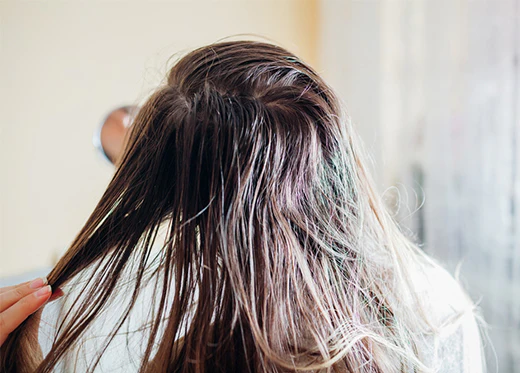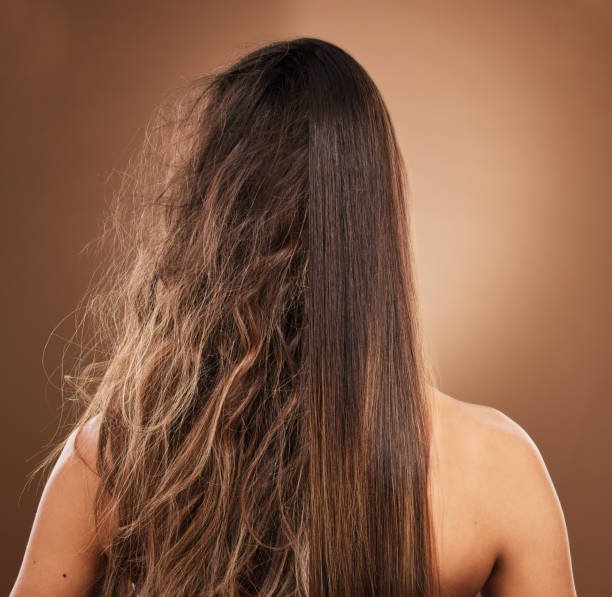
How do ı know my hair type?
Is Your Hair Fine, Medium, or Coarse?
This question refers to the thickness of individual hair strands, not the overall volume of hair. Here are three categories to help determine your hair type:
1. Fine Hair
Fine hair feels silky and thin. You’ll know you have fine hair if you can hardly feel a single strand between your fingers. Other signs include a ponytail that feels thin, even if you have a lot of hair. Additionally, fine hair often loses volume quickly after styling.
Tips for Fine Hair:
- Use volumizing shampoo and conditioner that clean without weighing hair down.
- Avoid heavy oils and creams as they can make hair greasy quickly. Instead, try dry shampoo at the roots to absorb excess oil and add volume.
- For haircuts, ask for layers to create the illusion of fuller hair.
- When styling, blow-dry with your head upside down to lift the roots and add volume.
- Be gentle with your fine hair as it breaks easily; use a wide-tooth comb and avoid tight hair ties.
2. Medium Hair
Medium hair is often considered the ideal type. It’s not too fine nor too coarse, and you can feel each strand when running your fingers through it. Medium hair has volume without being too thick, and ponytails often appear full.
How to Care for Medium Hair:
- Use a good quality shampoo and conditioner suited to your hair’s needs, whether it’s dry, oily, or balanced.
- Avoid washing your hair every day to preserve natural oils
- Styling medium-length hair is fun because you have options:
- Want to make it curly? Do it with ease.
- Prefer it straight and sleek? No problem.
- Your hair can handle heat styling, but don’t overdo it. Use a heat protectant spray to keep your strands healthy.
- Deep condition your hair once a week to keep it soft and manageable.
- Trim the ends regularly to keep it looking healthy.
3. Coarse Hair
Coarse hair is thick, strong, and dense. You’ll know you have coarse hair if it feels sturdy and thick when you touch a single strand. It’s often heavy, voluminous, and can sometimes be difficult to manage.
To determine if your hair is coarse: grab a strand and roll it between your fingers. It feels strong and thick, doesn’t it? Coarse hair is durable and can handle a lot of styling, but it can be stubborn and hard to manage if you don’t know how to care for it.
One of the biggest advantages of coarse hair is its natural volume. You have a natural thickness that fine-haired people dream of! However, coarse hair can be prone to frizz and dryness.
The key to managing coarse hair is moisture, moisture, moisture. Taking care of coarse hair revolves entirely around hydration.
- Use rich, creamy shampoos and conditioners.
- Don’t hesitate to use hair masks and deep-conditioning treatments.
- Oil is your best friend when it comes to coarse hair. Use it to smooth frizz and add shine.
Styling coarse hair can be a challenge, but it’s worth the effort. Your hair holds styles beautifully. Work with your hair’s natural texture, not against it.
Remember, coarse hair is strong, but it’s not invincible. Be gentle when detangling—start from the bottom and work your way up. And don’t overuse heat-styling tools. While your hair may tolerate them, excessive heat can cause damage over time.
How to Tell if Your Hair is Oily or Dry?
This question is all about your scalp’s oil production. If your scalp produces a lot of oil, your hair will be oily; if it produces very little, your hair will be dry. Knowing this will help you choose the right hair care routine for your needs.
Signs of Oily Hair
- Do you need to wash your hair daily?
- Does your hair look overly shiny the day after washing?
- Does your scalp feel greasy when you touch it?
If your answers are “yes,” then you may have oily hair.
How to Care for Oily Hair:
- Use a lightweight shampoo daily to remove excess oil.
- Avoid conditioning your scalp, applying conditioner only to the ends of your hair.
- Dry shampoo between washes to absorb extra oil.
- Avoid excessive touching or rubbing, as this stimulates more oil production.
Signs of Dry Hair
- Is your hair dull and rough to the touch?
- Do you experience frequent split ends or breakage?
- Does your scalp feel itchy?
If your answers are “yes,” then you may have dry hair.
How to Care for Dry Hair:
- Wash your hair no more than 2-3 times a week to preserve moisture.
- Use moisturizing shampoo and conditioner rich in natural oils.
- Apply a deep conditioning mask weekly to restore hydration.
- Avoid high heat when styling. Use a medium heat setting on your blow dryer.

Is My Hair Thick or Thin?
Now, let’s talk about hair density — the number of hair strands growing from your scalp, not the thickness of each strand.
The Average Person has 100,000 to 150,000 hair follicles. If you’re closer to 150,000, you have thick hair. If you’re closer to 90,000, you have thin hair.
1.Managing Thin Hair
Do you have thin hair? There are tricks to make it look fuller. Chemical coloring or texturizing treatments can plump up your strands, giving the illusion of thicker hair. Just be cautious—if your hair is fine and thin, these treatments can cause damage if not handled carefully.
When it comes to a hair care routine for thin hair, less is more. Volumizing products can help, but don’t overdo it to avoid potential damage. Here’s a pro tip: if you use hair masks or treatments, look for ones with strengthening proteins rather than heavy oil-based formulas.
2.Embracing Your Thick, Abundant Hair
For those lucky enough to have thick hair—you’ve got a head full of volume that ensures versatility in styles and a stunning look. However, it can be tricky to manage. Whether your strands are fine, medium, or coarse, thick hair requires structure to maintain its shape.
Regular trims are your best friend—they help manage the volume and keep your favorite hairstyle looking sharp. When choosing a haircut, layers can work wonders, but the key is maintaining a well-structured look.
Remember, whether your hair is thick or fine, it’s all about working with what you’ve got and finding a care routine that makes you feel confident and fabulous.

Is My Hair Curly or Straight?
This refers to the shape of individual strands of hair. If you were to cut a strand and look at it under a microscope, you would see whether it’s straight or curly.
1.Straight Hair
Straight hair has a round, smooth shaft that allows oils to travel from the scalp to the ends easily. This often results in shiny hair, though it may become greasy quickly.
How to Care for Straight Hair:
- Straight hair looks sleek with non-layered cuts. Be cautious with too many layers, as they can make thin straight hair appear even thinner.
2.Curly Hair
Curly hair has an oval or irregular shaft, which makes it harder for oils to travel along the strand, so curly hair tends to be drier. Curly hair often has natural volume and may not shine as much as straight hair.
How to Care for Curly Hair:
- Curly hair loves layered cuts that define the curls.
- Moisturizing treatments are essential to keep curls hydrated and frizz-free.
- Avoid over-washing, and use a sulfate-free shampoo to maintain natural oils.

How to Know Your Hair Type in 6 Simple Steps
Knowing your hair type helps you select the best products and styling techniques. If you use heat tools or styling products regularly, you may have forgotten what your natural hair texture is like. It’s time to get back to basics and determine your true hair type.
- Start fresh. Wash your hair with a regular shampoo, but do not use conditioner. This gives you a clean slate to assess your hair without any added product effects.
- Let your hair air dry naturally. Don’t use any heat styling tools or rub it dry with a towel. Just let it dry naturally.
-
Now, observe your hair closely. Once dry, assess your hair:
- Is it straight or wavy? If it’s wavy, is it loose or tight waves?
- For curly hair, check if the curls are tight or loose, or more wavy than curly.
- For curly hair, check if the curls are tight spirals, S-shaped, or more of a zigzag pattern. Some people have a mixture of textures – note the overall effect.
- Check the texture of your hair. Is it frizzy? Does it feel smooth or dry?
-
Examine individual strands. Take a strand and place it on a piece of white paper:
- If it’s hard to see and feels soft, your hair is fine.
- If it’s easy to see but still soft, it’s medium.
- If it’s thick and feels strong, it’s coarse.
-
Measure your hair’s density. To assess overall density, gather your hair into a ponytail and measure the circumference:
- Less than 5 cm (2 inches)? Thin hair.
- Between 5-10 cm (2-4 inches)? Medium hair.
- More than 10 cm (4 inches)? Thick hair.
Remember!
By following this guide, you’ll get a good idea of your hair type and how to care for it. You may have a mix of types – such as thin, wavy hair or thick, straight hair. Understanding your unique hair type is the first step to giving it the care it deserves and rocking the hairstyle that suits you








